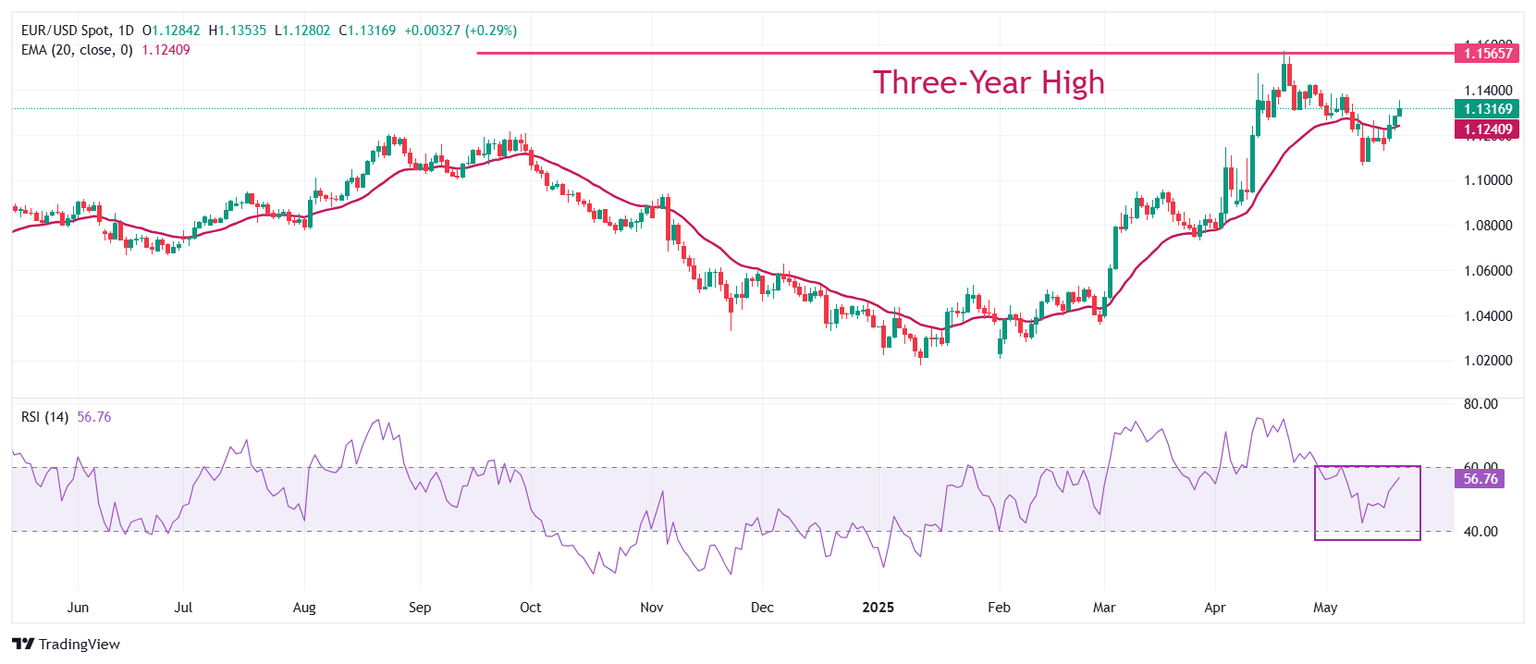EUR/USD advances on US downgrade, German Merz to meet US Trump for trade talks
- EUR/USD rises further to near 1.1350 as the US Dollar remains under pressure due to Moody’s downgrade to the US credit rating.
- US President Trump fails to convince lawmakers to back tax-cut bill.
- The Euro gains as Trump confirms Russia-Ukraine truce talks.

EUR/USD jumps to near 1.1350 on Wednesday, extending its winning streak for the third trading day. The major currency pair strengthens as the US Dollar (USD) continues to face a sharp selling pressure amid the United States (US) credit rating erosion. The US Dollar Index (DXY), which tracks the Greenback’s value against six major currencies, recoups some of its early losses, but is still 0.3% down to near 99.70.
Moody’s downgraded the US Sovereign Credit Rating to Aaa from Aa1 on Friday in the wake of fiscal imbalances and mounting interest rate obligations, a move that added concerns over the US Dollar’s credibility. The credit rating agency also showed solicitude over a likely increase in the current debt pile of $36 trillion, with US President Donald Trump aiming to pass a new tax bill of $3 trillion-$5 trillion.
Meanwhile, US President Trump failed to convince Republican lawmakers in a closed-door meeting on Capitol Hill on Tuesday to back the new tax bill through which he aims to fulfill his economic agenda. Republicans disagreed to support the tax-cut bill as they dissented the “increase in limits on deductions for state and local tax payments”, Republican Representative Mike Lawler said, Reuters reported.
On the economic front, investors await the preliminary S&P Global Purchasing Managers’ Index (PMI) data for May, which will be released on Thursday. The PMI data is expected to show that the overall business activity expanded at a steady pace. Investors will pay close attention to comments from employers in the private sector about whether they are opting for capacity expansion or are comfortable with costly imports due to the fallout of the tariff policy by the White House.
Federal Reserve (Fed) officials have indicated that the imposition of new economic policies by US President Trump is expected to de-anchor inflation, a scenario that discourages the central bank from bringing interest rates down. On Tuesday, St. Louis Fed Bank President Alberto Musalem said, “If inflation expectations become de-anchored, the Fed policy should prioritize price stability”. Musalem guided that the monetary policy is currently “well-positioned” as the economic policy uncertainty is “unusually high”.
Daily digest market movers: EUR/USD gains on Russia-Ukraine truce talks
- Sheer strength in the EUR/USD pair is also driven by the Euro’s (EUR) outperformance. The major currency performs strongly against all its major peers, except the Japanese Yen (JPY), on Wednesday as investors become hopeful of a truce between Russia and Ukraine. US President Trump confirmed Russia-Ukraine ceasefire talks in the Vatican City through a post on Truth.Social. “Russia and Ukraine will immediately start negotiations toward a ceasefire,” Trump said.
- A ceasefire between Russia and Ukraine will be a favorable scenario for the Euro (EUR) as it will ease supply chain disruptions across Europe. However, German Chancellor Friedrich Merz said during North American hours on Wednesday that there is no sign "the war in Ukraine will end soon," Reuters reported.
- On the monetary policy front, traders remain increasingly confident that the European Central Bank (ECB) will reduce interest rates in the June policy meeting. The reason behind firm ECB dovish bets is guidance from a slew of officials that inflation is on track to return to the central bank’s target of 2%.
- During European trading hours, ECB Governing Council member and Governor of the Bank of Portugal Mario Centeno argued in favor of more interest rate cuts to offset downside risks to Eurozone inflation. "The ECB may need to cut its key interest rate below the neutral level of 1.5%-2% to prevent inflation from falling below its 2% target," Centeno said.
- This week, the Spring Forecast report from the European Union’s (EU) executive arm also showed that inflation will return to the 2% target by the middle of the year. The report also showed that price pressures will average at 1.7% in 2026, a scenario that reflects downside risks to inflation.
- On the economic front, investors await the HCOB PMI data for the Eurozone and its major states, which will be released on Thursday. According to the preliminary estimates, the overall business activity is expected to have grown at a faster pace than what was seen in April.
- Meanwhile, investors also look for fresh cues about progress in trade talks between the Eurozone and the US. During North American trading hours, German Merz confirmed a meeting with US President Trump and signaled a proposal to remove tariffs on both sides. Merz expressed confidence that the US could be interested in having a trade deal with the EU.
Technical Analysis: EUR/USD stays above 1.1300

EUR/USD jumps to near 1.1350 on Wednesday, the highest level seen in two weeks. The near-term outlook of the pair is bullish as it holds the 20-day Exponential Moving Average (EMA), which is around 1.1240.
The 14-period Relative Strength Index (RSI) oscillates inside the 40.00-60.00 range, suggesting indecisiveness among traders.
Looking up, the April 28 high of 1.1425 will be the major resistance for the pair. Conversely, the psychological level of 1.1000 will be a key support for the Euro bulls.
US Dollar FAQs
The US Dollar (USD) is the official currency of the United States of America, and the ‘de facto’ currency of a significant number of other countries where it is found in circulation alongside local notes. It is the most heavily traded currency in the world, accounting for over 88% of all global foreign exchange turnover, or an average of $6.6 trillion in transactions per day, according to data from 2022. Following the second world war, the USD took over from the British Pound as the world’s reserve currency. For most of its history, the US Dollar was backed by Gold, until the Bretton Woods Agreement in 1971 when the Gold Standard went away.
The most important single factor impacting on the value of the US Dollar is monetary policy, which is shaped by the Federal Reserve (Fed). The Fed has two mandates: to achieve price stability (control inflation) and foster full employment. Its primary tool to achieve these two goals is by adjusting interest rates. When prices are rising too quickly and inflation is above the Fed’s 2% target, the Fed will raise rates, which helps the USD value. When inflation falls below 2% or the Unemployment Rate is too high, the Fed may lower interest rates, which weighs on the Greenback.
In extreme situations, the Federal Reserve can also print more Dollars and enact quantitative easing (QE). QE is the process by which the Fed substantially increases the flow of credit in a stuck financial system. It is a non-standard policy measure used when credit has dried up because banks will not lend to each other (out of the fear of counterparty default). It is a last resort when simply lowering interest rates is unlikely to achieve the necessary result. It was the Fed’s weapon of choice to combat the credit crunch that occurred during the Great Financial Crisis in 2008. It involves the Fed printing more Dollars and using them to buy US government bonds predominantly from financial institutions. QE usually leads to a weaker US Dollar.
Quantitative tightening (QT) is the reverse process whereby the Federal Reserve stops buying bonds from financial institutions and does not reinvest the principal from the bonds it holds maturing in new purchases. It is usually positive for the US Dollar.
Author

Sagar Dua
FXStreet
Sagar Dua is associated with the financial markets from his college days. Along with pursuing post-graduation in Commerce in 2014, he started his markets training with chart analysis.

















